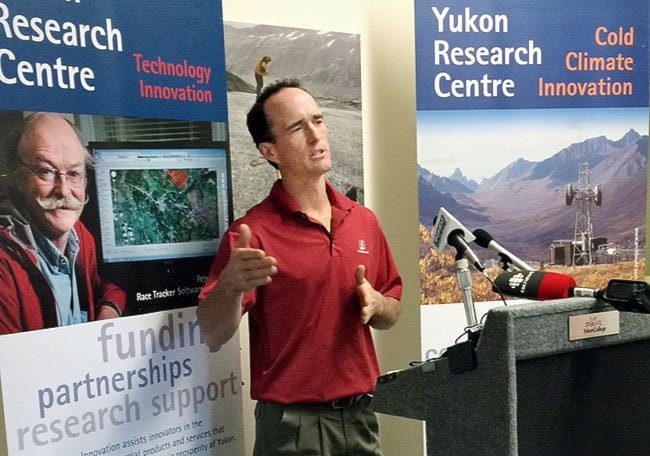Whitehorse resident Adam Greetham has won this year’s $60,000 Yukon Innovation Prize for a new technology to make radon mitigation safer and more efficient.
Greetham’s device could lead to energy savings for people in cold climates who live in homes with high levels of the radioactive gas.
Greetham, whose background is in environmental remediation, said he got the idea for his new invention after attending radon measurement and mitigation courses sponsored by Yukon Housing.
“I identified concerns and hazards within the radon mitigation industry in cold climates,” he said. “I have concerns that the performance may not be optimal.”
Radon gas exists naturally in certain kinds of soil, and it poses no health risks at low levels. But it can seep up into basements when the pressure inside the house is lower than outside. This happens primarily in the winter, when the warm air inside the house has a lower pressure than the cold air outside. A thick blanket of snow on the ground also increases pressure in the soil, which can help push radon gas up through the foundations of a house.
Radon gas can reach dangerous levels as it builds up inside a house. In fact, it’s the second-leading cause of lung cancer after smoking. To get rid of it, homeowners usually install a pipe from the ground beneath the floor slab out through the wall or roof of the house. A fan near the top of the pipe sucks air from the soil and pushes it out into the atmosphere, keeping the soil pressure low.
But in many homes, those fans run for much longer than necessary, and they often blow a lot of heat out of the house.
That’s where Greetham’s invention comes in. The device acts as a regulator - taking measurements and shutting off the fan as soon as the pressure inside the house is a little higher than the pressure in the soil beneath.
“It’s an automated system,” Greetham said. “It’s designed to provide optimum efficiency.”
His system could also guard against another health risk. As radon fans blow out air, the change in pressure can prevent furnaces and stoves from blowing carbon monoxide up chimneys and into the open air. Instead, the poisonous gas could build up inside the house. But if the fans only run when necessary, that risk is reduced.
The genius of Greetham’s idea is in its simplicity, said Stephen Mooney, director of Cold Climate Innovation at the Yukon Research Centre, which organized the competition. The device can simply be attached to a radon mitigation system that is already in use.
“What people don’t know is how much heat they’re really sucking out of their buildings,” he said. “All that fan is going to do now is just to turn enough to keep those pressures different. And I think it will be cost-effective.”
With the help of the Yukon Innovation Prize, Greetham hopes to have his invention on the shelves by January 2016. He plans to sell the devices to markets in Canada, the U.S., and Europe, for about $200 each.
And he’s decided to build a manufacturing and assembly plant right here in Whitehorse.
“I live here. I’ll always live here. I’ll never move away,” he said. “My objective personally is to assist Yukon.”
According to a Yukon Housing map from 2008, there are households with high radon levels in nearly every community in the territory.
The acceptable limit for radon gas is 200 becquerels per year, but Mooney said there are Yukon homes with four-digit radon levels. He recommends that all new homes should be built with radon mitigation piping in place, in case the gas turns out to be a problem.
Juergen Korn, research and development housing manager with Yukon Housing, said the number of homeowners testing their homes is on the rise, thanks to greater awareness of the health risks.
“There’s certainly more attention being paid to radon,” he said. “Every community has the potential and every household has the potential for a high reading.”
He added that it’s impossible to know how high radon levels will be until after a house is built, which is why testing is so important.
Contact Maura Forrest at
maura.forrest@yukon-news.com
